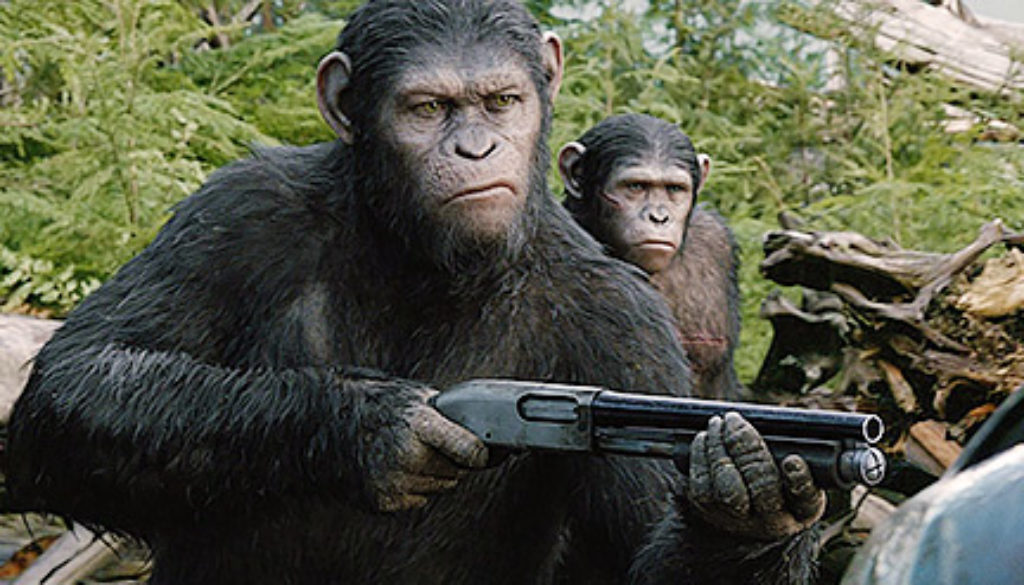
It’s been 10 years since Caesar and his throng of smart apes broke free from the test facility and ran for cover in the dense forests outside of San Francisco. Ten weary winters have passed since an unstoppable virus swept through humanity and left only small groups of the genetically immune alive. And in this now grossly underpopulated world, both men and apes have pretty much forgotten about each other.
Caesar and his enlightened charges are building a peaceful community. They’re using sign language, raising families, enjoying homes, hoping for the future. And as far as the deadly things that came before, this super-smart simian is determined to see an end to all that. “Ape Not Kill Ape” is scrawled on the classroom chalkboard for all the young ones to see.
At the same time the regrouping humans have gathered tools, medicines, food supplies—everything they can find in an attempt to get back to where they were before the horror started. Back to normal.
That calm on both sides, however, is now shattered by the booming concussion of a gunshot.
It wasn’t supposed to happen this way. Malcolm and his small group of human cohorts were simply hoping to reactivate a nearby dam and restore power to the city. But they accidentally wander into Caesar’s domain. An interspecies encounter results in an itchy trigger finger and a wounded ape.
Turns out the gunpowder in a single bullet has the power to blow up the whole world. And though Caesar and Malcolm both want to maintain peace and reason, a rising tide of anger and mistrust between the two groups may lead to an inevitable test of wills.
The film makes clear, through Caesar and Malcolm’s actions, that turning from wrath and finding common ground is the only wise choice when dealing with conflict. Even though man and beast clash for a time, they ultimately end up fighting for and sacrificing for each other as friends.
In fact, several human-ape friendships demonstrate that individuals from totally different walks of life can care about and learn from one another. Malcolm’s son Alexander, for instance, forms a bond with an orangutan teacher and they share a book. Ellie, Malcolm’s physician wife, works to save the lives of both Caesar and his mate.
Caesar repeatedly stresses that the only way to find a fulfilling and happy future is to turn from conflict and focus on building a family and a loving home—something he strives to do with his own mate and two little ones. That sentiment is reinforced when Caesar finds an old video of his deceased human friend Will who embraces him as a young ape and welcomes him into his home.
Beyond the underlying issue of wonky evolutionary development that the film can’t help but dust off, there’s a sense here of man’s (and, in this case, apes’ as well) fallen nature. Evil is real, even in the midst of those striving for a higher good.
Malcolm and his wife kiss.
This movie’s trailers trumpet the big battle scenes where apes ride in on horseback with spears and blazing guns. And that clash is indeed the core of the story. Both sides of the man-ape equation fear for their survival and rage at each other with explosive might. The results are only sometimes bloody but nearly always intense and perilous.
Caesar is shot and the ape village set on fire as a way to push the whole community toward war. And once that battle breaks out, RPGs and automatic weaponry destroy buildings, landscapes, men and apes alike. A score of apes are crushed by a bus as it rolls over. And many more are smashed by debris from a tower detonated by blocks of C4 explosive. Simians strike metal structures and platforms when they fall from great heights.
Apes grab and, you might say, manhandle innocent humans—slamming them to the ground, dragging them off and throwing them into cages. Koba, an older and war-hungry ape, points to his many ugly scars—gained while he was a lab test subject—and speaks of mankind’s savage ways. He later grabs a machine gun and riddles two men with bullets, point-blank. He jumps on an armored military vehicle, crushes and pummels its human occupants and uses its large-caliber gun to slaughter even more. After an ape follower refuses to murder a fallen human, Koba grabs the more conscientious ape and throws him to his death off a precipice.
Early on, the ape hordes go hunting, felling antelope and a bear with spears. Caesar’s son is raked by a bear’s sharp claws, the young ape’s chest torn and bloodied.
One f-word and at least a half-dozen s-words join a handful of uses each of “a–,” “b–ch” and “h—.” Jesus’ name is misused once; God’s is exclaimed a time or two as well.
Carver smokes a cigarette. Men drink from a bottle of booze while testing weapons.
Astounding action sequences.
Pattern of original sin.
Evolution.
Those oddly grouped-together words are not quite as fluid as a good haiku nor are they even meant to stand on their own as a clever acronym. Rather, they clearly describe the cinematic elements that stood out to me while watching this film.
First of all, Dawn of the Planet of the Apes is undeniably a dynamic chest-thump of a summer movie. Its dystopian world of crumbling cities, where ragged groups of men and apes battle for dominance, is vividly created—right down to the gritty death throes at times. The horse-riding, word-grunting ape/gorilla/monkey/orangutan characters are a feat of CGI brilliance. And the musical score is sweeping.
Second, there are parts of the story that strongly reminded me of spiritual things. The film itself doesn’t recognize any faith-focused elements—its creators would more likely see the story as a secular morality tale or perhaps a parable of extremism in the postmodern world. But it’s clear that man and intelligent ape alike both suffer from an underlying, corrupted, fallen nature that incessantly drives things toward the dark side. Caesar himself—the enlightened ape with dreams of a simian utopia—even pauses at one point to wonder how alike apes and men might be in their evil natures.
Then there’s the evolutionary side of the tale. But in this case I’m not talking about orangutan-turns-into-mountain-man transitions. Nope, you’ve long-ago figured out that this 4-decades-old franchise monkeys around with that sort of thing. Here I’m focusing on the sequel kind of evolution. Because Dawn of the Planet of the Apes often feels exactly like what it is: a second installment, a step in between, a transitional fossil. You know where it’s going and what it’s doing through every battle-torn twist and turn. It’s setting up that big trilogy conclusion, of course.


After spending more than two decades touring, directing, writing and producing for Christian theater and radio (most recently for Adventures in Odyssey, which he still contributes to), Bob joined the Plugged In staff to help us focus more heavily on video games. He is also one of our primary movie reviewers.